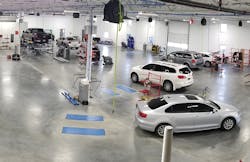One night, nearly a decade ago, Dan Morrow sat in his Lincoln, Neb. shop frustrated by a paint job that seemed as endless as Interstate 80.
“I was painting in the middle of the night, and I was thinking ‘Why is this job taking so long?,’” the owner of Morrow Collision Center recalls. “So, I grabbed a sheet of masking paper, stuck it on a booth wall and grabbed a Sharpie. Then, I started writing down how many minutes that I thought were being wasted on each step” of the repair process.
Like many operators of small, independent shops, Morrow simply didn’t have the space in his shop to allow vehicles to linger through a lengthy repair process. And, with just 5,400 square feet of shop space at his disposal, the shop owner needed to move as many vehicles through his facility as possible on a consistent basis.
So, on that night, almost 10 years ago, Morrow came up with the concept for his new facility’s shop floor. The new facility, he promised, would have a shop floor configured for a supremely efficient repair process. Now he boasts a new, 26,000-square-foot facility that features streamlined repair procedures.
In Morrow’s experience, there are a few keys to keep in mind when attempting to improve the efficiency of your shop’s repair processes. Those keys include the following:
Get veteran employees’ advice.
Morrow’s first shop location was plenty efficient, producing $1.6 million in annual revenue despite space limitations and just eight employees. But he wanted to take his business to the next level with his second shop, which opened in February. As a result, he sought feedback from veteran technicians, regarding issues like how the staff could get new parts on the shop floor as quickly as possible.
“This [new] shop design is very technician- and employee-driven,” Morrow notes. “We have constant communication with our techs, so we know what’s causing them problems. And that’s the kind of input we took to this whole place.
“At the new shop we’re getting away from scheduling by bringing a car in, disassembling, and blueprinting. We’re not in the business to store parts, so now those parts come in, they go on a cart … and then they get used right away.”
Prep things in advance.
Morrow feels shop staffs can set themselves up for success by dedicating at least one employee to coming in early and checking off small items on the facility’s to-do list, such as moving vehicles into specific technician’s stalls. Or, if a shop can afford to have an employee work late at night priming vehicles, that can also greatly aid overall repair efficiency, Morrow notes.
“Those kinds of steps are huge,” Morrow notes. “If everybody’s just working 8-5, then you’re just picking up where you left off [at the start of each workday], and you’ve got to get re-organized, and you’ve got a mess to clean up.”
If possible, load level.
When Morrow added a second shop, he re-thought the types of repairs that each of his facilities should typically handle. Now, the larger, newer facility tends to handle heavy hits. Meanwhile, the original Morrow Collision Center tends to handle smaller, quicker repair jobs.
“Part of what’s going to help the old shop is just to have a little less workflow,” Morrow notes, “so that, when the cars come in there, they can get through faster and more comfortably.”
Have great managers in place.
Morrow Collision Center wouldn’t be in the midst of its current surge if it weren’t for the fact the business’s leader has put the right administrators in place. For example, Tom Morrow (Dan’s brother), has ascended to a top managerial role and calls upon his previous experiences as an estimator and technician to help guide the Nebraska shops’ 15 combined employees.
The managerial appointments have paid off, judging by Morrow Collision Center’s 4.8-star average ranking on Google.
“If managers are invested and can be good teamwork motivators,” Dan Morrow notes, “then you’re going to have employees that don’t just do their job and go home, but are there to help each other out. Then everybody works as a team, and that’s the key to a small facility.”



